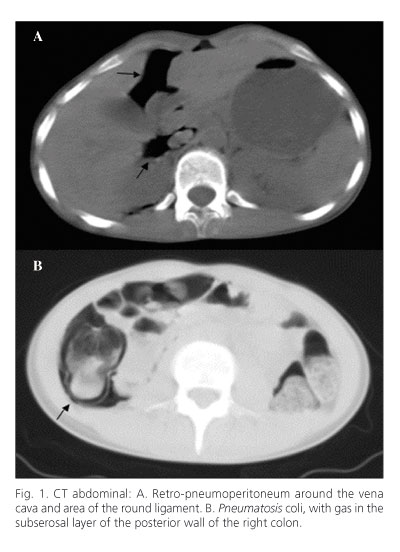Meu SciELO
Serviços Personalizados
Journal
Artigo
Indicadores
-
 Citado por SciELO
Citado por SciELO -
 Acessos
Acessos
Links relacionados
-
 Citado por Google
Citado por Google -
 Similares em
SciELO
Similares em
SciELO -
 Similares em Google
Similares em Google
Compartilhar
Revista Española de Enfermedades Digestivas
versão impressa ISSN 1130-0108
Rev. esp. enferm. dig. vol.103 no.7 Madrid Jul. 2011
https://dx.doi.org/10.4321/S1130-01082011000700017
LETTERS TO THE EDITOR
Colonic pneumatosis intestinalis in a patient with neutropenia secondary to anorexia nervosa
Neumatosis intestinal de colon en un paciente con neutropenia secundaria a la anorexia nerviosa
Key words: Pneumatosis cystoides intestinalis. Pneumoperitoneum. Anorexia nervosa. Neutropenia.
Dear Editor,
Cystic pneumatosis intestinalis is a rare benign entity, characterized by intramural cysts located mainly in the intestinal wall. The etiology has not yet been elucidated, but generally it is associated with a systemic disease (1-4). Colonic pneumatosis represents about 30% of gastrointestinal cases (1). We present the case of a young girl with anorexia who underwent surgical treatment for cystic colonic pneumatosis intestinalis.
Case report
An eighteen-year-old girl diagnosed with anorexia nervosa was admitted to the emergency unit because of pain in the right lower quadrant of eight days duration. Physical examination revealed a painful right lower abdominal quadrant and abdominal distension. On the fourth day of admission the pain increased and was accompanied by nausea and vomiting. Physical examination revealed signs of peritoneal irritation. Laboratory investigations showed a count of 1,300 white cells with a total neutrophil count 195/µL. A non-enhanced CT scan showed pneumoperitoneum localized in the right upper abdominal quadrant and retro-pneumoperitoneum around the vena cava, right renal capsule, and both psoas muscles (Fig. 1).
Surgical treatment was chosen because of the signs of peritonism and the raised white cell count suggestive of early sepsis. At laparotomy, abundant serous peritoneal fluid (culture negative) and intestinal pneumatosis affecting the right colon were observed. A right colectomy was performed.
Macroscopically, pathological examination revealed edema with loss of the intestinal folds and hemorrhagic spots in the mucous layer of the cecum. The complete wall thickening of the intestine was substituted with multiple cysts formations. Microscopically multiple cysts were found throughout the thickened intestinal wall. In the cecum, areas of haematic extravasations and capillary congestion were identified.
Discussion
Pneumomediastinum is a rare complication described in patients with anorexia nervosa. However, no case of pneumatosis intestinalis has been reported in patients with anorexia nervosa. The term "pneumatosis" is applied to all cases of intramural gas irrespective of the causative process. It has been associated to a large number of underlying diseases (1-4). It has been associated with a large number of underlying diseases (1-4) and has been described in patients with neutropenia and with immunocompromise due to steroids, chemotherapy, radiotherapy, or AIDS (2,4). Neutropenia, although not universally present, may contribute to the etiology. The only link between our case and other reported cases of intestinal pneumatosis was the neutropenia. Lower leukocyte, neutrophil, and red cell counts are significantly correlated with the severity of anorexia nervosa (5).
The pathogenesis of pneumatosis intestinalis remains unknown but several theories have been postulated. The mechanical theory suggests that the presence of an anatomical lesion -allows the spread of intraluminal gas into the wall of the gastrointestinal tract. The inflammatory theory proposes that a combination of bacterial overgrowth, intestinal obstruction, and immunosuppression allows air to pass into the gastrointestinal wall together with bacteria. The most accepted theory, however, is chemical. This theory proposes that disaccharidase deficiency and increases in lactic acid secondary to diet alter the metabolism of carbohydrates, increasing bacterial fermentation, producing large amounts of gas, increasing the intraluminal pressure, and allowing diffusion of gas in the gastrointestinal wall.
In our case, no ileo-colic damage or intestinal infection was detected, making it difficult to ascertain the mechanism that allowed massive air entry into and through the bowel wall. Although we had a diagnosis of intestinal pneumatosis, we decided on surgical treatment because of the signs of intestinal perforation and the possibility that the leucopenia and neutropenia indicated developing sepsis.
Juan José Arenal1, Awwad Said1, Claudia Tinoco1,María José Mato2, Monstserrat Otero2 and José Ángel Guerro2
1Department of Surgery. Hospital Universitario Río Hortega. Valladolid, Spain. 2Department of Radiology. Hospital de Medina del Campo. Valladolid, Spain
References
1. Godlewski G, Prudhomme M, Tang J, Mattei M, Courtial P, Orcel M, et al. Pneumatosis cystoides of the colon. Apropos of 7 cases. Chirurgie 1997;122:455-62. [ Links ]
2. Pear BL. Pneumatosis intestinalis: a review. Radiology 1998; 207(1): 13-9. [ Links ]
3. Gagliardi G, Thompson IW, Hershman MJ, Forbes A, Hawley PR, Talbot IC. Pneumatosis coli: a proposed pathogenesis based on study of 25 cases and review of the literature. Int J Colorectal Dis 1996;11 (3):111-8. [ Links ]
4. Ade-Ajayi N, Veys P, Stanton M, Drake DP, Pierro A. Conservative management of pneumatosis intestinalis and pneumoperitoneum following bone-marrow transplantation. Pediatr Surg Int 2002;18:692-5. [ Links ]
5. Devuyst O, Lambert M, Rodhain J, Lefebvre C, Coche E. Haematological changes and infectious complications in anorexia nervosa: case control study. Q J Med 1993;86:791-9. [ Links ]















